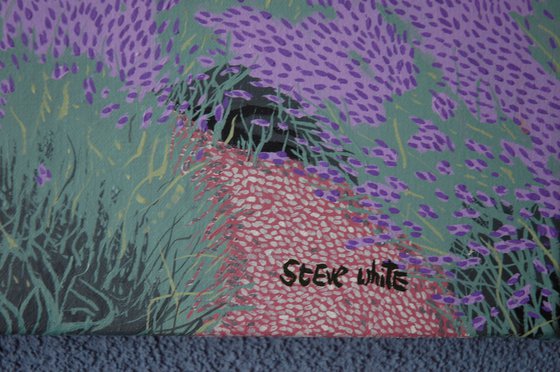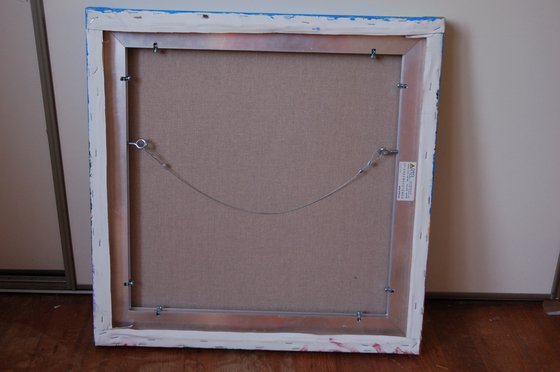Original artwork description:
Many truly great artists were also gardeners: I fit into neither category. Gardening is boring: a fact I have verified on Google. Planting nasturtiums or onions is a dull undertaking. But the ends justifies the beans. Even I can appreciate a handsome plot riddled with mimosas and triteleias. And it is not hard to see why artists are drawn to the soil. Apart from never leaving their kitchens at all, and forever painting Still Lifes of randomly arranged combinations of soup tureens, aubergines, tea towels, decanters of red wine and dead rabbits, gardens are the next laziest thing to paint. A garden can be a technicolour orgy of organic forms, and it's right outside the back door. Thanks God! But don't give up your day job just yet. Italian-American composer Gian Carlo Menotti urges caution: 'Art is the unceasing effort to compete with the beauty of flowers - and never succeeding.'
With his infamous paintings of his flooded 2 hectare allotment in Giverney, Claude Monet leads the field in celebrity green-fingered dabbling. For the last 30 years of his life the bearded wonder painted up to 250 pictures of his lovingly tended water lilies. You might think that once you've seen one picture of lovingly tended water lilies you've seen 250 of them; and you would be absolutely correct. But don't blame Monet. Right up until his death, it was the gift that just kept on giverning.
Fellow Frenchman Gustave Caillebotte, a friend, patron and purchaser of many Monets, inherited family wealth which meant that he could survive without selling his own competent paintings, mostly of urban Paris. After buying a plot of land in Argenteuil on the Seine near Paris he actually gave up painting altogether at the age of 34 to become a fulltime gardener, a career trajectory, in my estimation, for which an expression using the words sublime and ridiculous was explicitly coined.
Another Frenchman who was keen on not going much further than his own back garden in order to find inspiration was Pierre Bonnard who, unlike Monet and Caillebotte, took his horticultural idleness seriously by letting his garden run free, thus disproving the notion that to be a competent painter of gardens you also had to be a competent gardener.
German artist Emil Nolde created a garden in Seebull, near the German/Danish border, specifically to feed his painting habit. There are those amongst us who might well remark that their children could do better flower paintings than Nolde's. Connoiseurs, however, prefer to laud his 'heightened sense of colour,' whatever that means. Angela Merkel recently requested that two of Nolde's work be removed from her office. No reasons were given. However embarrassing recent revelations of Nolde's Nazi sympathies have emerged, even though the Nazi's banned Nolde’s work as degenerate. But let's be generous and say that Nolde was not excommunicated by Merkel because he worshiped Hitler, but because his ‘heightened sense of colour’ clashed with the beige shade of Angela's favourite trouser suit.
So gardens are an inspiration to artists? Quelle surpreese. But for every artist-gardener there are probably a zillion artless-gardeners who wouldn't know their easel from their elbow. I don't see the work of Monty Don or Charlie Dimmock work hanging in the RA.
This painting is not our garden. Even if we got rid of our four trash bins it would require the ingestion of a trugload of drugs to find the smallest similarity between the two. In theory I suppose I could paint our back yard. It has its own down-at-heel charm. David Hockney paints the smallest details of his current modest back garden in Normandy. As Confucius say: 'Everything has beauty but not everyone sees it.' But David Hockney is David Hockney. He has earned the right to paint whatever he wants.
I will paint my garden when I am famous. But I ain't going to weed the lavender.
Limited Edition Prints.
Printed on William Turner Hahnemuhle fine art exhibition quality paper (310 g/m2) using Epson Ultrachrome Pro Pigments, the colours remain true to the original up to 100 years.
The image size is 40×40 cms and there is an additional 3 cms border all the way round the image (ie total size: 46×46 cms). The artist will sign and number the print in this border. The print is unframed.
Prints will leave the artists studio within 7 days, rolled in a heavy tube, accompanied by a Certificate of Authenticity and sent via track and trace.
Materials used:
Acrylics
Tags:
#flowers #garden #roses #moonlight #lavenderFeatured by our Editors:
Lavender Garden (2020)
Acrylic painting
by Steve White
1 Artist Reviews
£645.38
- Acrylic painting on Canvas
- One of a kind artwork
- Size: 60 x 60 x 4.5cm (unframed) / 60 x 60cm (actual image size)
- Ready to hang
- Signed on the front
- Style: Impressionistic
- Subject: Flowers and plants
Original artwork description
Many truly great artists were also gardeners: I fit into neither category. Gardening is boring: a fact I have verified on Google. Planting nasturtiums or onions is a dull undertaking. But the ends justifies the beans. Even I can appreciate a handsome plot riddled with mimosas and triteleias. And it is not hard to see why artists are drawn to the soil. Apart from never leaving their kitchens at all, and forever painting Still Lifes of randomly arranged combinations of soup tureens, aubergines, tea towels, decanters of red wine and dead rabbits, gardens are the next laziest thing to paint. A garden can be a technicolour orgy of organic forms, and it's right outside the back door. Thanks God! But don't give up your day job just yet. Italian-American composer Gian Carlo Menotti urges caution: 'Art is the unceasing effort to compete with the beauty of flowers - and never succeeding.'
With his infamous paintings of his flooded 2 hectare allotment in Giverney, Claude Monet leads the field in celebrity green-fingered dabbling. For the last 30 years of his life the bearded wonder painted up to 250 pictures of his lovingly tended water lilies. You might think that once you've seen one picture of lovingly tended water lilies you've seen 250 of them; and you would be absolutely correct. But don't blame Monet. Right up until his death, it was the gift that just kept on giverning.
Fellow Frenchman Gustave Caillebotte, a friend, patron and purchaser of many Monets, inherited family wealth which meant that he could survive without selling his own competent paintings, mostly of urban Paris. After buying a plot of land in Argenteuil on the Seine near Paris he actually gave up painting altogether at the age of 34 to become a fulltime gardener, a career trajectory, in my estimation, for which an expression using the words sublime and ridiculous was explicitly coined.
Another Frenchman who was keen on not going much further than his own back garden in order to find inspiration was Pierre Bonnard who, unlike Monet and Caillebotte, took his horticultural idleness seriously by letting his garden run free, thus disproving the notion that to be a competent painter of gardens you also had to be a competent gardener.
German artist Emil Nolde created a garden in Seebull, near the German/Danish border, specifically to feed his painting habit. There are those amongst us who might well remark that their children could do better flower paintings than Nolde's. Connoiseurs, however, prefer to laud his 'heightened sense of colour,' whatever that means. Angela Merkel recently requested that two of Nolde's work be removed from her office. No reasons were given. However embarrassing recent revelations of Nolde's Nazi sympathies have emerged, even though the Nazi's banned Nolde’s work as degenerate. But let's be generous and say that Nolde was not excommunicated by Merkel because he worshiped Hitler, but because his ‘heightened sense of colour’ clashed with the beige shade of Angela's favourite trouser suit.
So gardens are an inspiration to artists? Quelle surpreese. But for every artist-gardener there are probably a zillion artless-gardeners who wouldn't know their easel from their elbow. I don't see the work of Monty Don or Charlie Dimmock work hanging in the RA.
This painting is not our garden. Even if we got rid of our four trash bins it would require the ingestion of a trugload of drugs to find the smallest similarity between the two. In theory I suppose I could paint our back yard. It has its own down-at-heel charm. David Hockney paints the smallest details of his current modest back garden in Normandy. As Confucius say: 'Everything has beauty but not everyone sees it.' But David Hockney is David Hockney. He has earned the right to paint whatever he wants.
I will paint my garden when I am famous. But I ain't going to weed the lavender.
Limited Edition Prints.
Printed on William Turner Hahnemuhle fine art exhibition quality paper (310 g/m2) using Epson Ultrachrome Pro Pigments, the colours remain true to the original up to 100 years.
The image size is 40×40 cms and there is an additional 3 cms border all the way round the image (ie total size: 46×46 cms). The artist will sign and number the print in this border. The print is unframed.
Prints will leave the artists studio within 7 days, rolled in a heavy tube, accompanied by a Certificate of Authenticity and sent via track and trace.
Materials used:
Acrylics
Tags:
#flowers #garden #roses #moonlight #lavenderFeatured by our Editors:
Returns and refunds
We want you to love your art! If you are not completely satisfied with your purchase you can return it free within 14 days, no questions asked. Learn more
Artist Reviews (1)
This artwork is sold by Steve White from Netherlands








